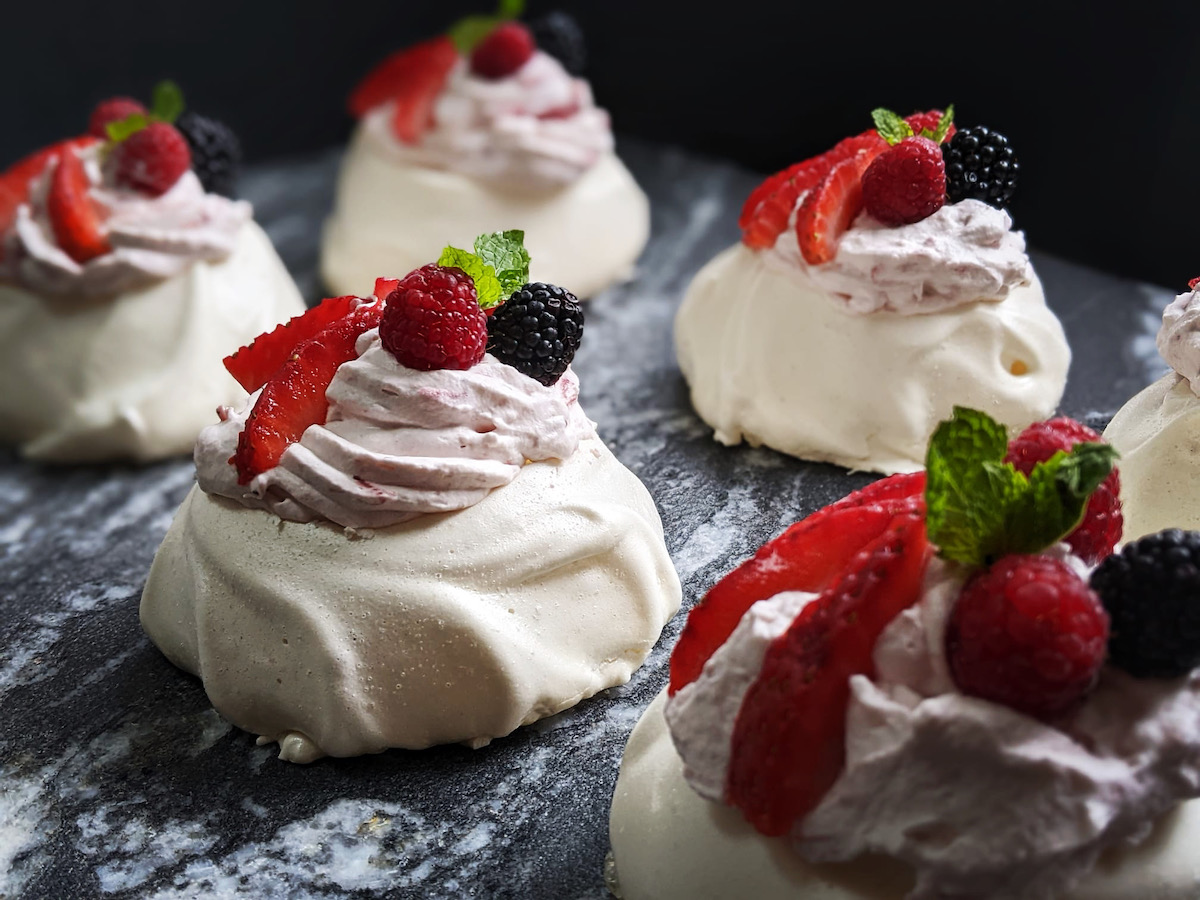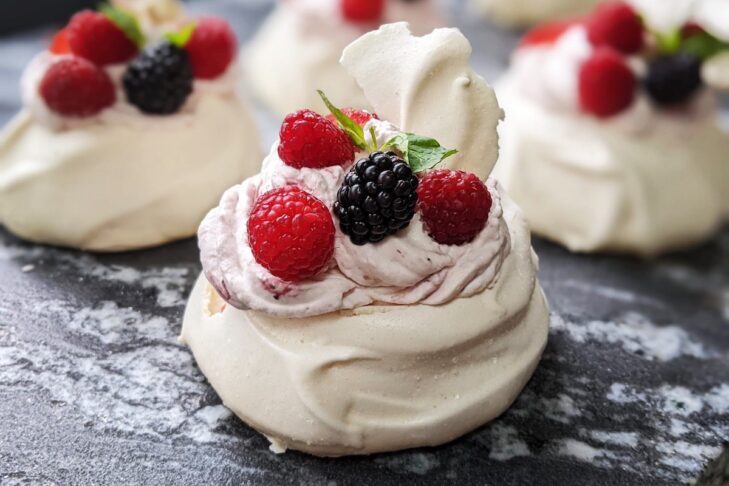Passover deserves a dessert worthy of celebration, and a pavlova is just that. Perfect for entertaining larger soirées or simply enjoyed amongst an intimate gathering, a pavlova’s gluten-free meringue base makes it naturally kosher for Passover. Inspired by the skirts of the famous Russian ballerina Anna Pavlova, this gorgeous, marshmallow-y meringue, piled high with a mound of whipped cream and berries, is the perfect sweet end to a seder meal.
My version of this elegant dessert yields individual servings for ease of plating and impressive presentation. A quick strawberry-rhubarb preserve folded through the whipped cream sets this pavlova apart, adding a citrusy, floral note that welcomes spring to the table. Topped with fresh berries and sprigs of mint, you will make this showstopper dessert again and again!
Taking on a multi-layered meringue dessert can seem overwhelming and a bit daunting, but fear not—the meringue and preserves can be made a day ahead of time and assembled before plating. To make this dessert dairy-free, please see the note below.

Strawberry Rhubarb Pavlova
Yields 8 individual-sized pavlovas
Ingredients
- 5 large egg whites at room temperature
- Pinch of salt
- 3 tablespoons cold water
- 1¼ cups super-fine sugar (see notes below)
- 1 teaspoon fresh lemon juice
- 1 teaspoon vanilla
- 1 tablespoon plus 1 teaspoon potato starch
- 1 pound strawberries, hulled and cut into 1-inch pieces
- 2 ounces (roughly an 11’’ stalk) rhubarb, stringy fibers peeled away and cut into 1-inch pieces
- 1½–2 tablespoons raw sugar
- ½ tablespoon fresh lemon juice
- Drop of vanilla (about 1/16 teaspoon)
- ¾ teaspoon combination of lemon and orange zests
- 1½ cups heavy whipping cream
- Strawberries, raspberries, blackberries and mint leaves for garnishing
Directions
- For the pavlova meringue: Preheat the oven to 275 degrees. Prepare a large cookie sheet with parchment paper. Using a small tea saucer or cookie cutter, trace eight 3-inch circles with a pencil. Evenly space them on the parchment paper. Flip the parchment paper over so the pencil markings are facing the cookie sheet.
- In the bowl of a stand mixer with a whisk attachment (or using a hand mixer), whip the egg whites and salt on medium-high speed until medium-stiff peaks appear.
- Reduce the speed of the mixer to low and slowly drizzle the water into the bowl.
- Place the mixer on medium speed and slowly add the sugar with a spoon, giving it a chance to dissolve between each spoonful.
- Place the mixer on medium-high speed and whip until stiff peaks form and the meringue is very shiny and silky (make sure the peaks are stiff, otherwise your meringue will be difficult to shape before baking).
- Turn off the mixer, remove the whisk attachment and set aside. Add the lemon juice, vanilla and potato starch to the meringue. Use the whisk attachment to slowly and carefully fold the added ingredients in by hand until fully incorporated.
- Carefully spoon the meringue evenly amongst the eight circles on the cookie sheet. Using a small rubber spatula, offset spatula or the back of a small spoon, smooth out the sides of your meringue mounds. Use fluid motions to mound the meringue and create lovely lines and movement. Slightly flatten the top of each mound, smoothing the edges as you work.
- Place the meringues in the oven for 15 minutes and then immediately reduce the oven temperature to 225 degrees for an additional 30 minutes. Do not open the oven at any point.
- When the final 30 minutes are up, turn off the oven and turn the oven light on but do not open the oven. Leave the meringues in the oven, light on, either overnight or for several hours (roughly five).
- Gently remove the cookie sheet from the oven and carefully peel away the meringues from the parchment paper. Once cooled completely, you can either fill them and serve or cover them with a cotton dish towel and store in a cool, dry place until you are ready to fill and serve them.
- For the strawberry-rhubarb preserve (yields 1 cup preserve): In a 1½-quart saucepan, combine the strawberries, rhubarb, raw sugar and lemon juice.
- Bring to a simmer and stir frequently, making sure the bottom does not burn. Cook for roughly 30 minutes, or until the preserve has reduced by at least half. The preserve will be “set” when you dip a wooden spoon into the pot, take your finger and draw a line through the back of the coated spoon. If the wiped line holds and doesn’t run, your preserve is ready.
- Remove from heat and add lemon and orange zests and vanilla. Stir to incorporate.
- Place in a lidded glass jar and chill in the refrigerator until needed.
- For the unsweetened whipped cream: In a stand mixer with a whisk attachment (or using a hand mixer), whisk heavy whipping cream until medium-stiff peaks form. Set aside.
- Assemble the pavlovas: Remove 8 teaspoons preserve from the jar it has been stored in and set aside. Using a rubber spatula, gently fold the remaining strawberry-rhubarb preserve into the whipped cream and set aside.
- Using a very sharp knife, crack open the very top of the meringues, cutting a circular opening. Reserve the shards that are cut away for decorating the top of your pavlovas.
- Add 1 teaspoon preserve to the inside bottom of each meringue, spreading evenly.
- Gently spoon or use a piping bag to fill the cavity of each meringue with the whipped cream. Allow the mound of cream to rise slightly above the top of each meringue.
- Arrange the top of the meringues with freshly sliced strawberries, raspberries, blackberries and mint leaves. Carefully place a shard of meringue reserved from cutting the tops open amongst the fresh berries.
Notes:
- To make this dessert dairy-free, replace the whipping cream with full-fat coconut cream. Refrigerate the can of coconut cream overnight. Carefully scoop out the thick cream, leaving the coconut water in the can. Whip the coconut cream until stiff peaks form and continue with folding in the preserves as instructed in the recipe.
- Double the preserve recipe and use it to schmear over matzah, swirl into yogurt or spoon over ice cream.
- Separate the eggs while they are fridge-cold, but wait until the whites are at room temperature to whip.
- If you can’t find super-fine sugar, simply add white granulated sugar into your food processor or blender for a few good whirls. Super-fine sugar is easier to dissolve into the meringue, leaving you with a smoother meringue.
- A clean, completely dry bowl is essential for your whites to whip properly. If the bowl is not completely clean and dry, your whites will not whip.
- Be sure to whip your meringue into stiff peaks, otherwise you will not be able to properly shape your pavlova for baking.
- When baking the meringues, do not open the oven door—no peeking!
- Don’t worry if your meringues crack! They simply add character to your dessert. And remember, whipped cream hides all cracks!



